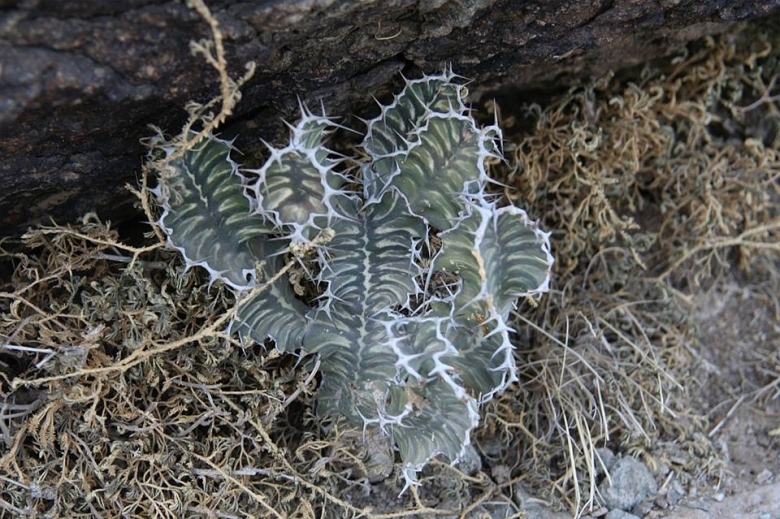




Your support is critical to our success.

Yemen 2008.
Origin and Habitat: Arabian Peninsula (Yemen, Oman, and Dhofar) across the Red Sea into Sudan (Red Sea Hills) and Eritrea.
Altitude range: From sea level to 2000 metres.
Habitat and ecology: Euphorbia cactusSN|33881]]SN|33881]], a CAM plant, is a common succulent plant growing in southern Arabia in deserts where high temperature is a common feature of the climate. In the Yemen mountains, Euphorbia cactusSN|33881]]SN|33881]] is the dominant species associated with several other succulent species such as Ceropegia rupicolaSN|32219]]SN|32219]] and Caralluma cicatricosa.
Synonyms:
- Euphorbia cactus Ehrenb. ex Boiss.
Euphorbia cactus Ehrenb. ex Boiss.
Prodr. [A. P. de Candolle] 15(2): 82 1862.
Synonymy: 3
- Euphorbia cactus Ehrenb. ex Boiss.
- Euphorbia cactus var. aureovariegata Schweinf.
- Euphorbia cactus var. tortirama Rauh & Lavranos
ENGLISH: cactus spurge, candelabra-tree
GERMAN (Deutsch): Kaktus-Wolfsmilch
Description: Euphorbia cactus is a cactus-like spiny succulent-stemmed, shrub, up to 1(-3) m tall, much wider than tall, with arched branches, stems 3 (-4) angular, 3.6 cm wide, irregular segmented, dark grey green, the ribs handsomely edged whit short, paired thorns. Spiny ribs with continuous, grey border. Epidermis blue-green, marked with contrasting, wavy bands. Tiny, waxy, yellow flowers are produced along upper ribs in autumn. Euphorbia cactusSN|33881]]SN|33881]] is very variable especially in stem morphology.
Stems: Succulent, candelabrum-like, with a very short main stem and few to numerous, ascending, usually 3-edged (seldom 4 or 5), grey-green (reddish brown at the tip), darkly marbled branches. Branches, very waisted when young, 5-10 cm wide, irregular segmented into ovate or pyramidal, segments with sinuate teeth to 1.5 cm apart, glabrous. Spines shield joined into a continuous, horny, undulating or zig-zagging margin to 5 mm wide, bearing stout paired, 1-2(-4) cm long stipular spines, leather reddish brown at first becoming whitish-brown along the length of the ridges, very hard and greatly flared, and also secondary spines flanking the inflorescence to 7 mm long.
Leaves: 2-4 mm long, 4-6 mm across, transversely ovate, soon falling.
Flowers (cyathia): Numerous in the apical region of the shoot, axillary, sessile or subsessile, in groups of 3 in a horizontal line, the central cyathium male and developing first, the lateral two bisexual, obscuring the male cyathium as they develop. Bracts leaf-like, deciduous. Involucre cup-shaped, 8-9 mm across, c. 5 mm deep. Cyathial glands 5 yellow-green, elliptic, just touching, c. 1.5 mm long, 3.5 mm across; marginal lobes with fimbriate margins. Male flowers numerous, reduced to one stamen,pedicel 3.5-4 mm long, bracteoles fimbriate. Female flowers subsessile, ovary glabrous, style arms c. 3.5 mm long, connate for c. 2 mm below, bifid at apex.
Fruits (capsules): 7-9(-15) mm in diameter, subglobose, 3-lobed, erect, sessile, glabrous ripening reddish brown.
Seeds: Subglobose, c. 3 mm in diameter, grey, smooth.
Similar species: Euphorbia cactusSN|33881]]SN|33881]] and Euphorbia fractiflexa look much alike. However in Euphorbis cactus the stem is with distinct, pyramidal segments. In E. fractiflexa the stem has wavy angles and is without pyramidal segments.
Subspecies, varieties, forms and cultivars of plants belonging to the Euphorbia cactus group
 Euphorbia cactus Ehrenb. ex Boiss.
Euphorbia cactus Ehrenb. ex Boiss.- Euphorbia cactus var. aureovariegata Schweinf.: has a marbled epidermis.
- Euphorbia cactus var. tortirama Rauh & Lavranos: has spirally twisted stems. Distribution: Yemen (Hadhramaut).
Bibliography: Major references and further lectures
1) Urs Eggli “Illustrated Handbook of Succulent Plants: Dicotyledons” Springer Science & Business Media, 2002
2) Shaukat Ali Chaudhary, ?Abd al-?Az?z ?Abb?s Juwayd, Markaz al-Wa?an? li-Ab??th al-Zir??ah wa-al-Miy?h (Saudi Arabia), Saudi Arabia. Wiz?rat al-Zir??ah wa-al-Miy?h “Vegetation of the Kingdom of Saudi Arabia” al-Markaz al-Wa?an? li-Ab??th al-Zir??ah wa-al-Miy?h, Wiz?rat al-Zir??ah wa-al-Miy?h, al-Mamlakah al-?Arab?yah al-Sa??d?yah, 1999
3) Kamal H. Batanouny “Plants in the Deserts of the Middle East” Springer Science & Business Media, 11 November 2013
4) Shahina A. Ghazanfar, Annette Patzelt “Flora of the Sultanate of Oman”, Volume 2 National Botanic Garden, 2007
5) Anthony G. Miller, Miranda Morris, Susanna Stuart-Smith “Plants of Dhofar: The Southern Region of Oman: Traditional, Economic and Medicinal Uses” Office of the Advisor for Conservation of the Environment, Diwan of Royal Court, 1988
6) Werner Rauh “The Wonderful World of Succulents: Cultivation and Description of Selected Succulent Plants Other Than Cacti” Smithsonian Institution Press, 1984
7) “The Plantsman” New Perspectives Pub., 1992
8) Philip Mathew, M. Sivadasan “Diversity and taxonomy of tropical flowering plants” Mentor Books, 1998
9) Miller, A.G & Morris, M. 1997. “Plants of Dhofar, Southern Region of Oman: Traditional, Economic and Medicinal Uses”. Office of the Adviser for Conservation of the Environment, Diwan of Royal Court, Sultanate of Oman.
10) Énum. Pl. Fleurs Afr. Trop. 1: 215 (1991).
Cultivation and Propagation: The true Euphorbia cactusSN|33881]]SN|33881]], seldom found in cultivation, is a very pretty species that, because of its dry, hot origins, requires a very warm soil and only a little water.
| Your Actions | |
|---|---|
| Back to Euphorbia index | |
| Back to Euphorbiaceae index | |
 |
Back to Succulents Encyclopedia index |
Privacy stantement - Terms and conditions - How to cite - About us - Feedback - Donate



